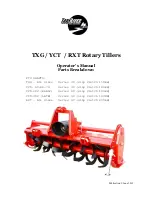
FORM 160.75-O1 (309)
25
JOHNSON CONTROLS
6
Vacuum testing
After the pressure test has been completed, the vacuum
test should be conducted as follows:
1. Connect a high capacity vacuum pump, with indica-
tor, to the system charging valve as shown in FIG. 9
and start the pump. (See “Vacuum Dehydration”.)
2. Open wide all system valves. Be sure all valves to
the atmosphere are closed.
3. Operate the vacuum pump in accordance with
VACUUM DEhYDRATiON
until a wet bulb
temperature of +32°F or a pressure of 5 mm Hg is
reached. See Table 2 for corresponding values of
pressure.
4. To improve evacuation circulate hot water (not to
exceed 125°F, 51.7ºC) through the evaporator and
condenser tubes to thoroughly dehydrate the shells.
If a source of hot water is not readily available, a
portable water heater should be employed.
DO NOT
USE STEAM
. A suggested method is to connect a
hose between the source of hot water under pres-
sure and the evaporator head drain connection, out
the evaporator vent connection, into the condenser
head drain and out the condenser vent. To avoid the
possibility of causing leaks, the temperature should
be brought up slowly so that the tubes and shell are
heated evenly.
5. Close the system charging valve and the stop valve
between the vacuum indicator and the vacuum pump.
Then disconnect the vacuum pump leaving the vac-
uum indicator in place.
6. Hold the vacuum obtained in Step 3 in the system for
8 hours; the slightest rise in pressure indicates a leak
or the presence of moisture, or both. If, after 24 hours
the wet bulb temperature in the vacuum indicator has
not risen above 40°F (4.4°C) or a pressure of 6.3 mm
Hg, the system may be considered tight.
Be sure the vacuum indicator is valved
off while holding the system vacuum
and be sure to open the valve between
the vacuum indicator and the system
when checking the vacuum after the
8 hour period.
7. If the vacuum does not hold for 8 hours within the
limits specified in Step 6 above, the leak must be
found and repaired.
taBle 2 –
SYSTEM PRESSuRES
*gAugE
ABSOLuTE
BOILINg
INCHES OF
TEMPERATuRES
MERCuRY (Hg)
MILLIMETERS
OF
BELOw ONE
PSIA
OF MERCuRY
MICRONS
wATER
STANDARD
(Hg)
°F
ATMOSPHERE
0
14.696
760.
760,000
212
10.24"
9.629
500.
500,000
192
22.05"
3.865
200.
200,000
151
25.98"
1.935
100.
100,000
124
27.95"
.968
50.
50,000
101
28.94"
.481
25.
25,000
78
29.53"
.192
10.
10,000
52
29.67"
.122
6.3
6,300
40
29.72"
.099
5.
5,000
35
29.842"
.039
2.
2,000
15
29.882"
.019
1.0
1,000
+1
29.901"
.010
.5
500
–11
29.917"
.002
.1
100
–38
29.919"
.001
.05
50
–50
29.9206"
.0002
.01
10
–70
29.921"
0
0
0
*One standard atmosphere
= 14.696 PSIA
= 760 mm Hg. absolute pressure at 32°F
= 29.921 inches Hg. absolute at 32°F
NOTES: PSIA = Lbs. per sq. in. gauge pressure
= Pressure above atmosphere
PSIA = Lbs. per sq. in. absolute pressure
= Sum of gauge plus atmospheric pressure
Summary of Contents for York MaxE YK Series
Page 2: ...Page 2 of 2 ...
Page 3: ......
Page 4: ......
Page 5: ......
Page 6: ......
Page 7: ......
Page 8: ......
Page 9: ......
Page 10: ......
Page 11: ......
Page 12: ......
Page 13: ......
Page 14: ......
Page 15: ......
Page 16: ......
Page 17: ......
Page 18: ......
Page 19: ......
Page 20: ......
Page 21: ......
Page 22: ......
Page 23: ......
Page 24: ......
Page 25: ......
Page 26: ......
Page 27: ......
Page 28: ......
Page 29: ......
Page 30: ......
Page 31: ......
Page 32: ......
Page 33: ......
Page 34: ......
Page 35: ......
Page 36: ......
Page 37: ......
Page 38: ......
Page 39: ......
Page 40: ......
Page 41: ......
Page 42: ......
Page 43: ......
Page 44: ......
Page 45: ......
Page 46: ......
Page 47: ......
Page 48: ......
Page 49: ......
Page 50: ......
Page 51: ......
Page 52: ......
Page 53: ......
Page 54: ......
Page 55: ......
Page 56: ......
Page 57: ......
Page 58: ......
Page 59: ......
Page 60: ......
Page 61: ......
Page 62: ......
Page 63: ......
Page 135: ...JOHNSON CONTROLS FORM 160 75 O1 309 36 SI metric conversion ...
Page 137: ...JOHNSON CONTROLS FORM 160 75 O1 309 38 NOTES ...
Page 138: ...FORM 160 75 O1 309 39 JOHNSON CONTROLS NOTES ...
















































